Over the last few years, Fernando Diniz has become one of the most polarising managers in Brazilian football. The 48-year-old made a name for himself after taking an incredibly limited team in Grêmio Osasco Audax to the final of the 2016 Paulista. In this historic run, Audax eliminated two giants in Corinthians and São Paulo. Since then, Diniz has managed Athletico Paranaense, Fluminense, São Paulo, Santos, Vasco da Gama, and now Fluminense again.
Despite having never won a trophy in his managerial career, Fernando Diniz is widely considered to be one of the best Brazilian managers after Tite. Contrary to most modern managers and their constant battle for space through positional play, Diniz adopts fluid possession-based tactics based on constant approximation and numerical superiority. This approach has earned him a cult-like following, claimed by many to have preserved Brazil’s true tactical identity. While some may do so by comparing his style to Telê Santana’s historic 1982 Brazil side, his recent revival of Paulo Henrique Ganso is the best example. The death of the classic number 10 has been one of the most notorious effects of modern football. Players like Boca Juniors and Villarreal’s Riquelme or Barcelona and Napoli’s Maradona are extremely rare nowadays, and PH Ganso is one of the few left. Since his glorious Santos days, Ganso has struggled to perform at an elite level. However, 10 years later, Fernando Diniz has made him the centrepiece of this Fluminense side.
In this tactical analysis, we will examine Diniz’s tactics at Fluminense by looking at their behaviour and structure throughout multiple phases of the game. In addition to identifying key principles and ideas in this analysis, we will also be able to identify how Diniz revived the classic number 10 role through PH Ganso.
Formations
First, it is important to identify the formation and structure adopted by Fernando Diniz. The Brazilian manager is quite adaptable with his formation choices, often considering the characteristics of the players at his disposal. At Fluminense, he has opted for a 4-2-3-1 most of the time. While this is the initial organisation of the players, it is hardly a rigid structure. In one of their matches’ average positions, we are able to see how narrow and close to each other the front four is.
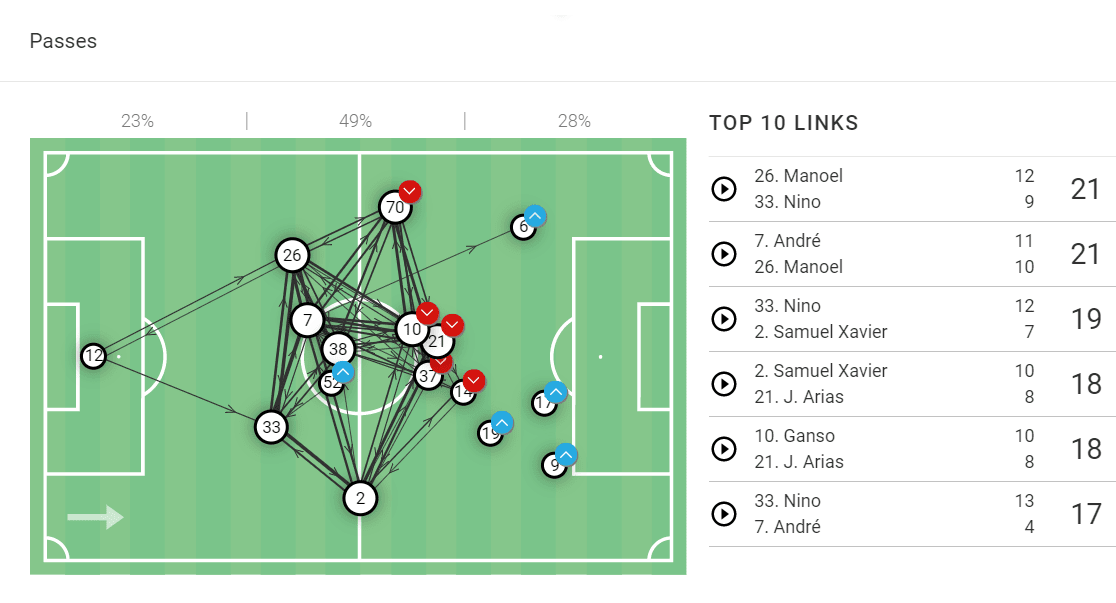
In a more extreme example, we are clearly able to identify the guiding principles of this Fluminense side. Their structure is incredibly narrow, based on constant approximation and numerical superiority. As a result, the players’ average positions are all near each other. A 4-2-3-1 structure can still be found, but due to different individual roles, it looks slightly different.
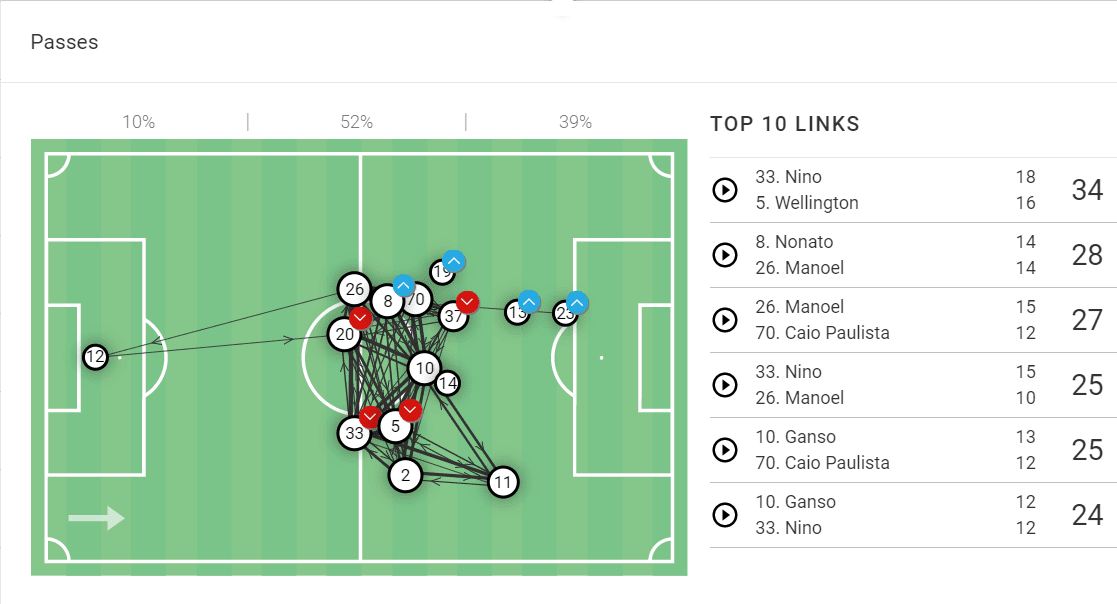
Build up
Fernando Diniz likes his sides to construct possession through a controlled approach. Essentially, this means collectively building out of the back with short passes, progressing through the zones with absolute control of the ball. While the directness of the passing is rather short, their tempo is quite high. In the 2022 Brasileiro, Fluminense have one of the highest passing rates at 14.8 passes per minute of possession. Furthermore, they average the lowest long passes per 90 at 31.14 despite averaging 418.98 passes per 90, the fourth highest in the league. These metrics essentially demonstrate how Flu have a high volume of passing at a very controlled level.
In order to examine how they build up, it is first important to understand the structure through which they do so. Initially maintaining a 4-2 shape, the goalkeeper also gets involved. His involvement is crucial as they are constantly trying to create a plus one superiority in this phase. The double-pivot is also important as their support to either side will create superiority in specific areas.

The first and perhaps main concept in the build-up is approximation. Players are constantly trying to create passing lanes by positioning themselves either between lines or in small gaps within the opposition’s press. The battle is not for space, but rather to create optimal passing options considering the player’s body positioning, the defensive organisation, and the location of other teammates. In the example below, as Nino receives the ball, three players instantly make themselves available.
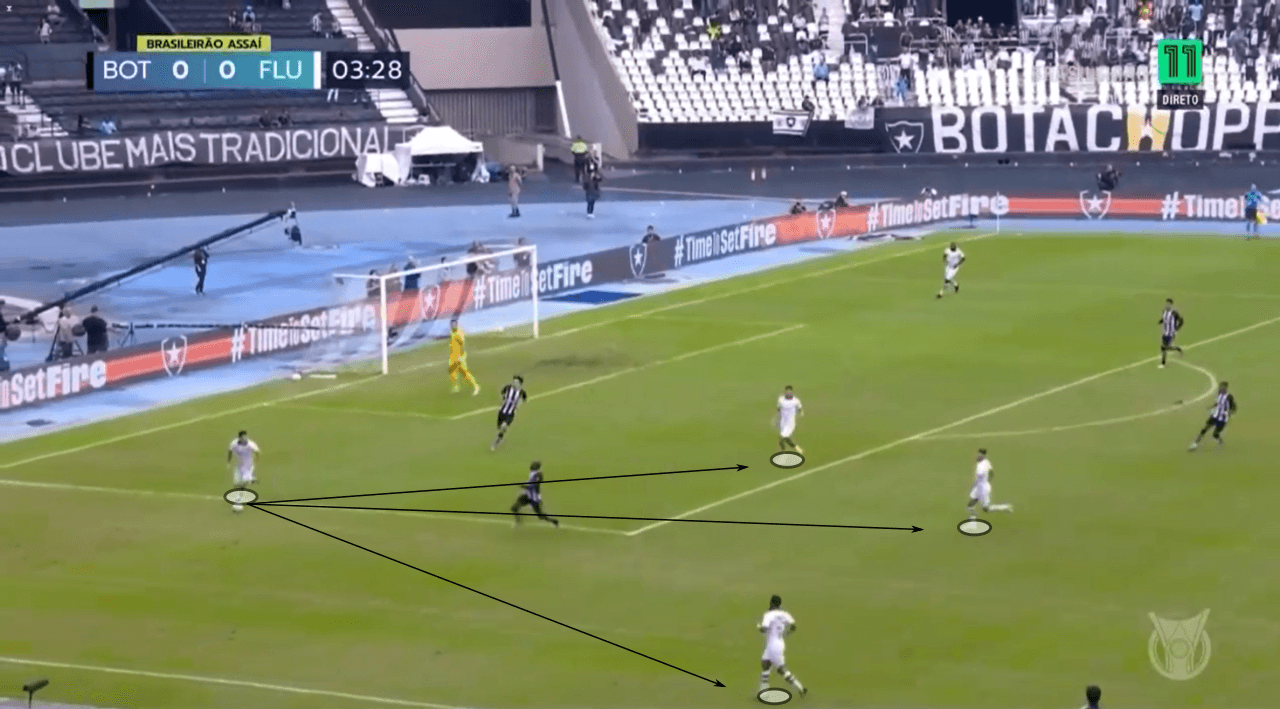
In addition to creating optimal passing lanes, Fluminense are also constantly trying to create numerical superiority. For example, in the specific section of the pitch below, the Tricolor create a 5v2 scenario by having the goalkeeper and both defensive midfielders come over.
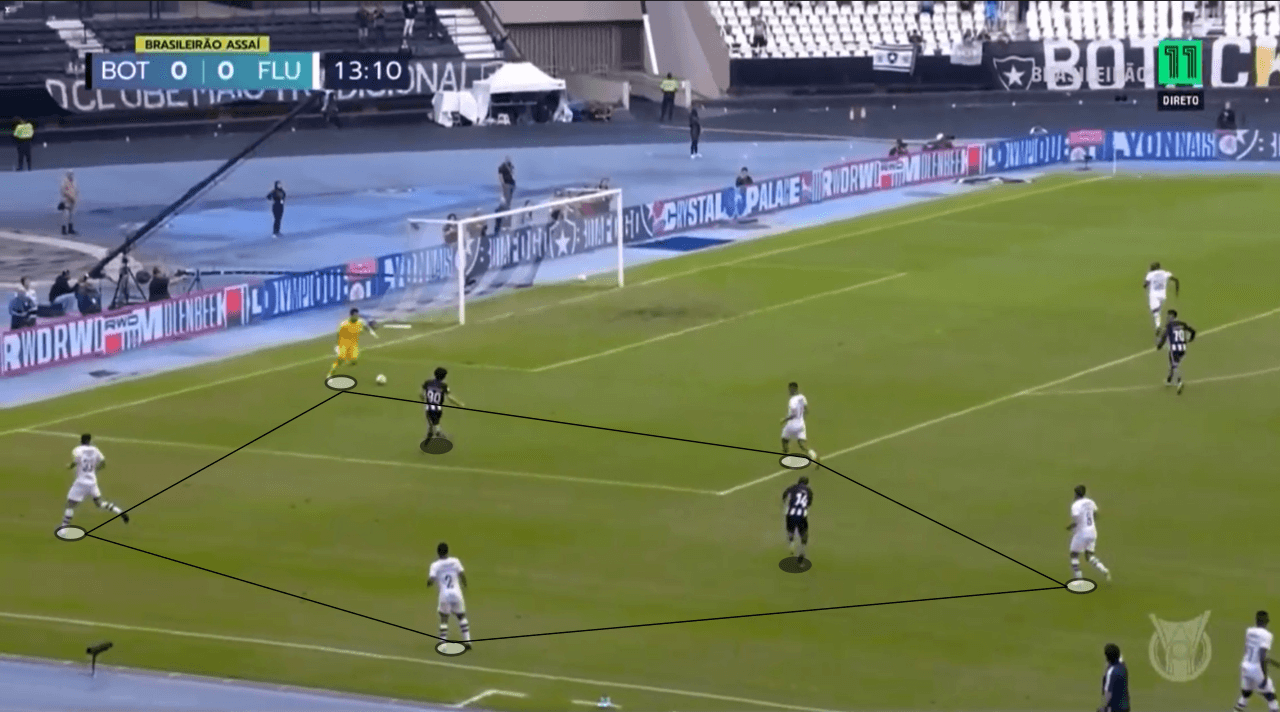
Finally, the third man is another concept adopted by Fernando Diniz. This concept has become quite popular in recent years, and it can be used in various systems. Essentially, this principle requires players from further up the pitch to make themselves available behind the first or second line of pressure. In the example below, Botafogo have matched Flu’s four players with a rather aggressive press. As a consequence, Ganso drops in from deeper to make himself available and provide that outlet.
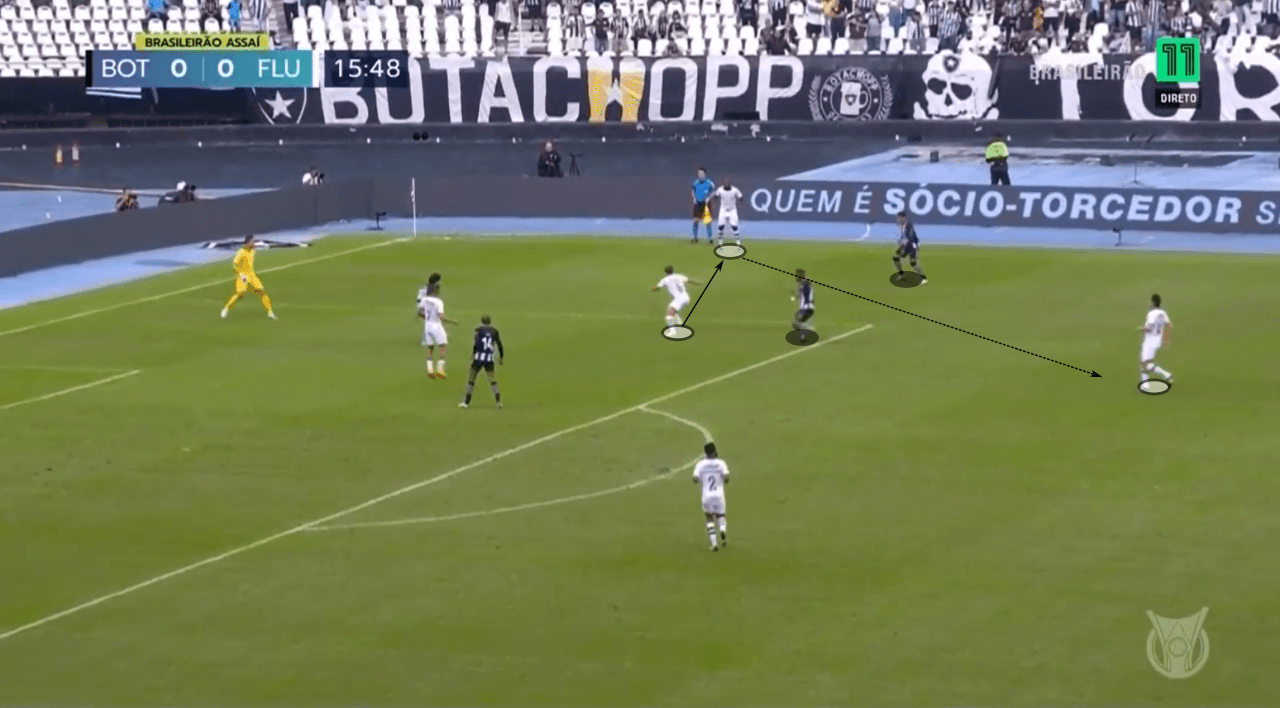
Progression
Diniz likes his teams to dominate possession, suffocating the opposition in their half. The Tricolor have the third-highest average possession in the league, with 55.9% possession. As a consequence, a significant part of their work with the ball involves progressing the ball from the middle to the final third to create chances. Obviously, Diniz demands absolute control and collective football in this phase as well. This positively results in getting to the final third with not only complete control of the ball but also with many options available, as we will see in the next section. First, though, it is important to understand how they progress through the middle third so effectively.
Nearly all the concepts and principles used in the build-up phase are maintained in the progression phase, especially creating overloads. By creating overloads in specific sections, they are able to create rondo-like scenarios where they outnumber the opposition and simply progress around them. For instance, by having one of the defensive midfielders move wide, they are able to have another midfielder come over. With the forward ahead of them, they are able to create a 4v1 scenario and easily pass around the Corinthians player.
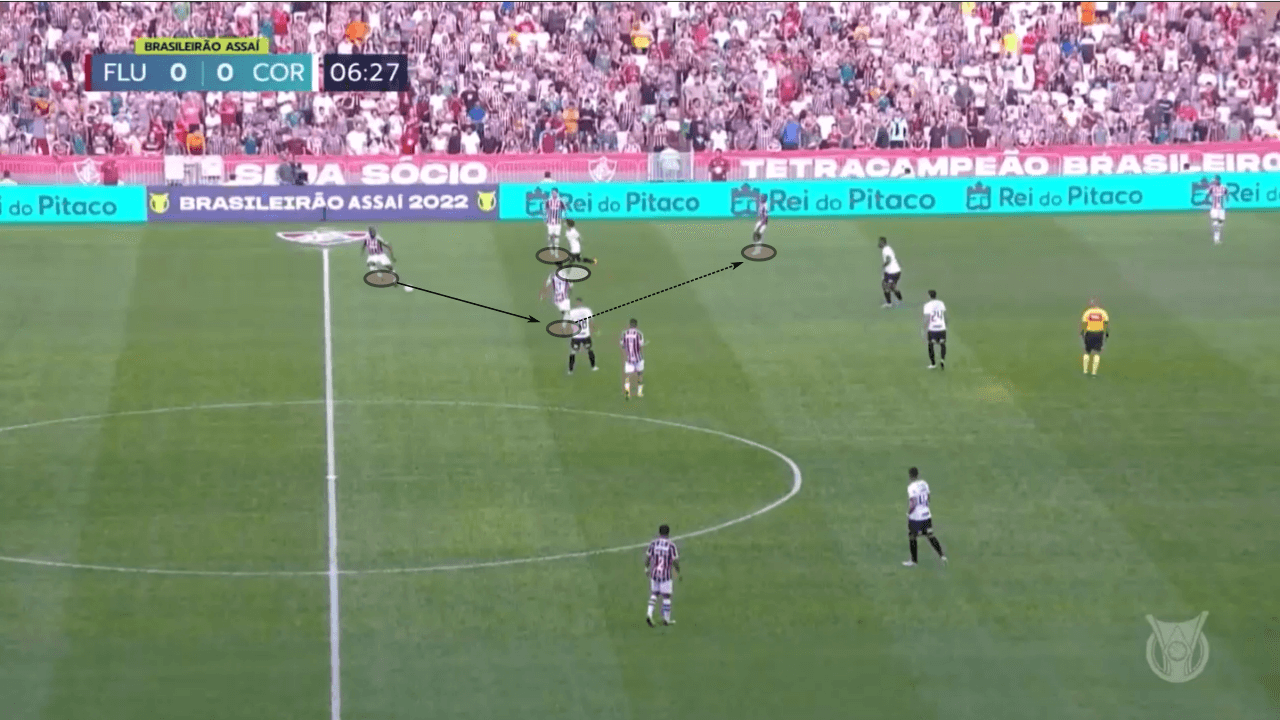
Combinations are another strategy consistently adopted by Fluminense. This involves a significant level of coordination between the players, as these combinations are fluid and complex. Rather than simple first-time passes between players standing still, these combinations are based on movement off the ball and rotations. Against Botafogo, we are able to identify an example of this. As Nonato breaks the midfield line to find Caio Paulista, Ganso immediately moves off the ball to receive a first-time pass from Caio. These combinations are extremely effective in disorganising the defence and allowing them to progress to the final third.
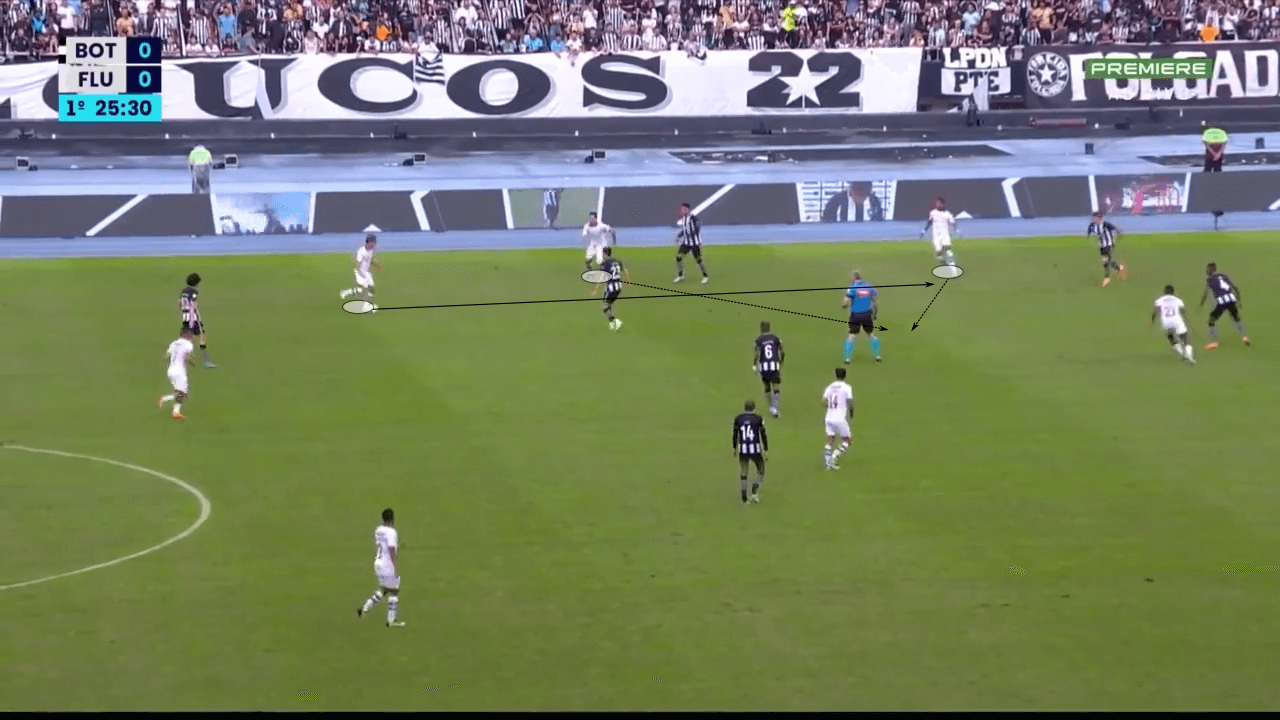
It is impossible to talk about combinations without mentioning PH Ganso. As mentioned, Diniz has made the number 10 the most important piece of this Flu side. He is essentially the orchestrator that, with heavenly technical ability, is able to command the attack and create. Ganso is the tactical reference in possession, as his work on and off the ball is crucial for them to create. This can be seen through his passing map. On the right side, we are able to see his top combinations in a given match. In this match, he has 20+ passing combinations with over half of his teammates.
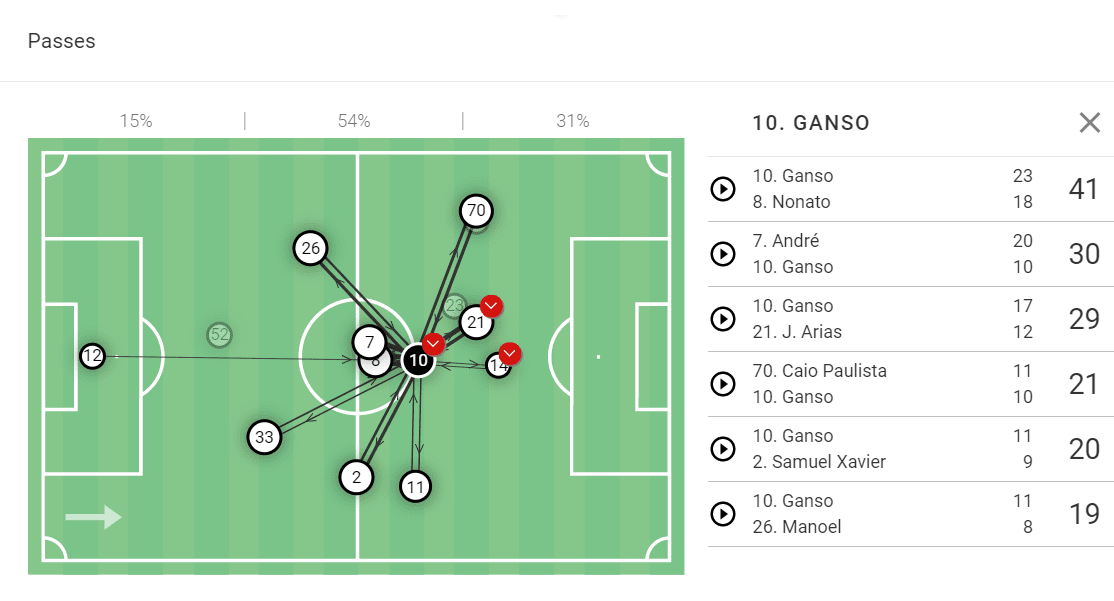
In this simple example, we are able to perfectly illustrate an aspect of his role. As Jhon Arias receives the ball from Ganso in the wide channel, he plays it back inside to Ganso. As he receives it, Ganso finds Nonato behind him with a simple first-time backheel. Nonato plays it back to Ganso who immediately plays it back to Jhon Arias, now in a dangerous space in front of the box. It is these sorts of first-time combinations that make him a pivotal part of this attack. Similar to a classic number 10, his minimal yet brilliant movement puts him in optimal places where his teammates can interact with him to retain possession and create chances.
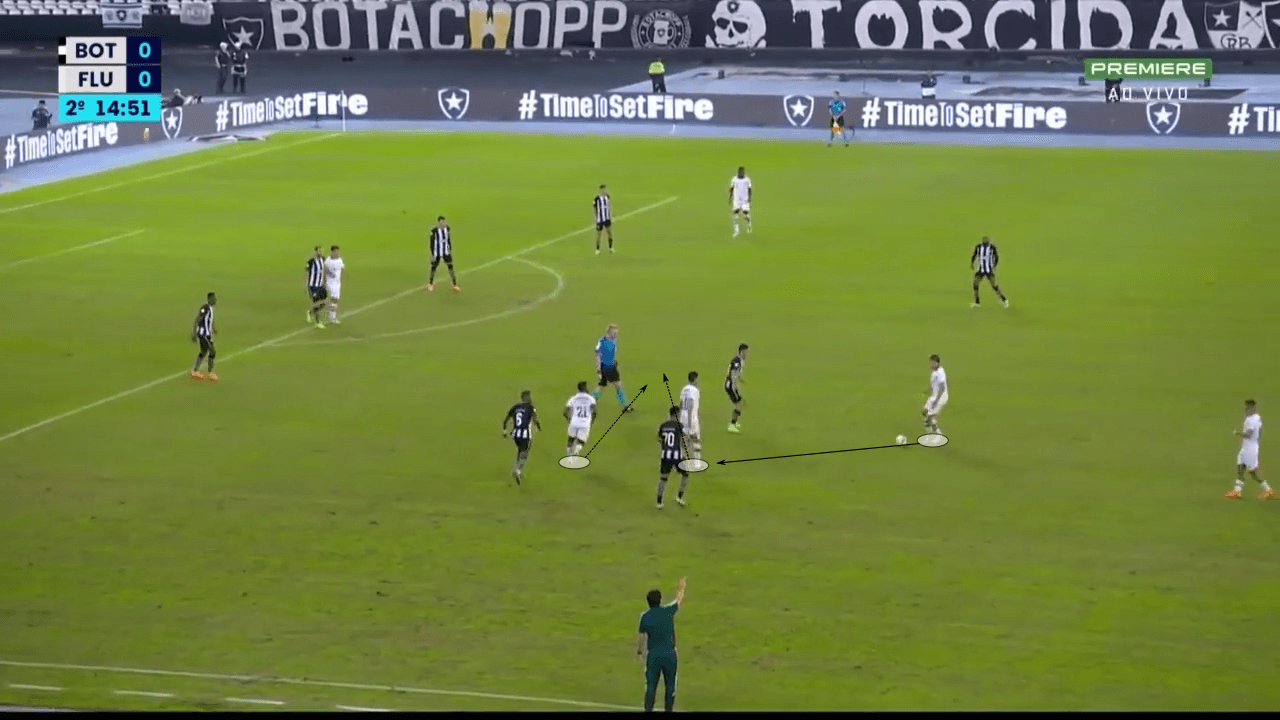
Rotations and constant movement are further concepts that can be identified in Fluminense’s progression. This constant rotation allows them to have a free-flowing and fluid system that is not only difficult to defend but also beautiful to watch. In the example below, André plays it wide to Caio Paulista. Immediately after making the pass, he makes a run down the pitch.
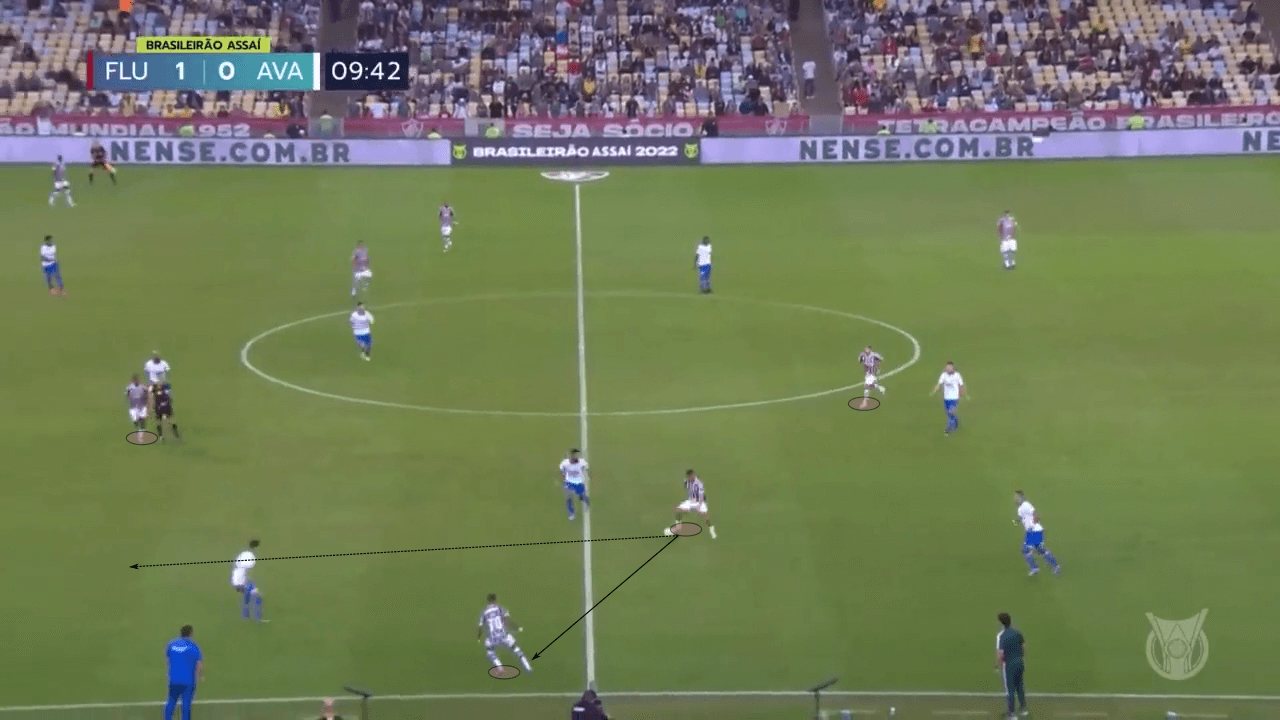
By making this run, he drags the opposition player with him and creates a lot of space. This space is immediately attacked by Jhon Arias and Nonato who make themselves available.
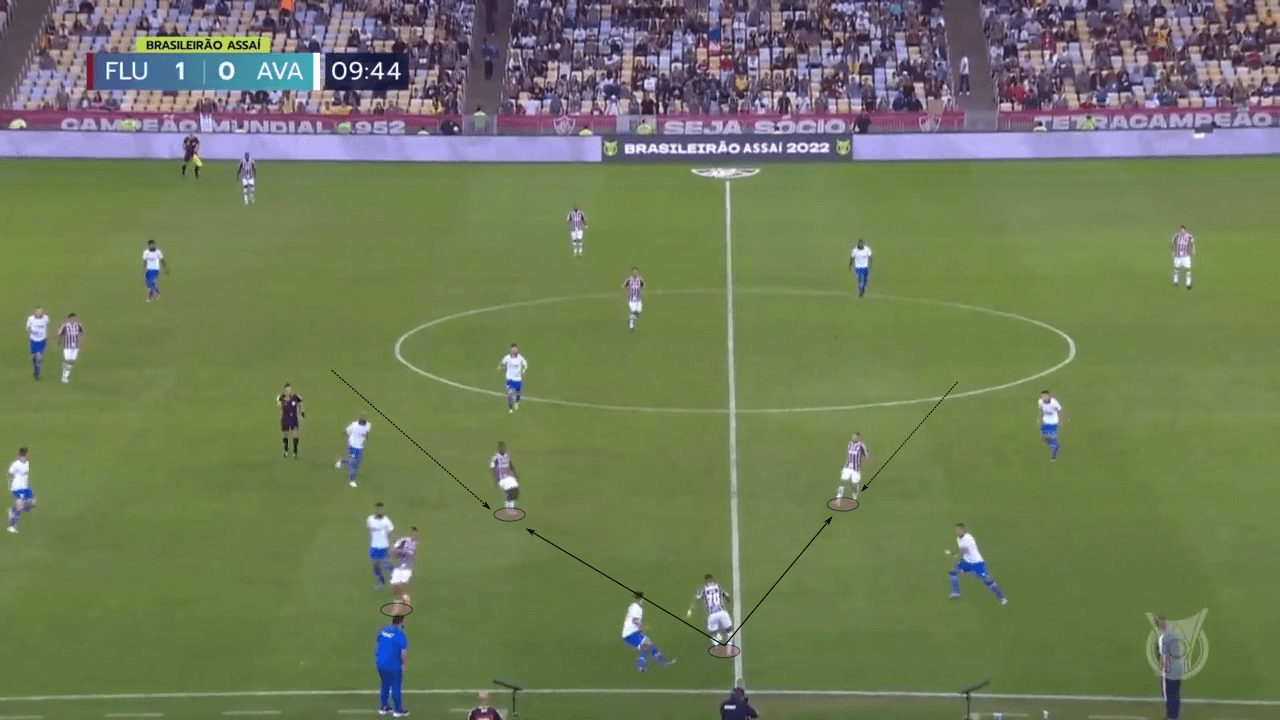
As discussed multiple times, numerical superiority is a key principle in Flu’s possession. Consequently, they attract a significant number of opposition players into a specific area of the pitch. This creates a tremendous amount of space elsewhere, and Diniz likes his team to occasionally exploit this. Against Cruzeiro, they are able to attract five players to that specific area of the pitch. Samuel Xavier then plays it to Ganso, who makes the long switch to Caio Paulista.
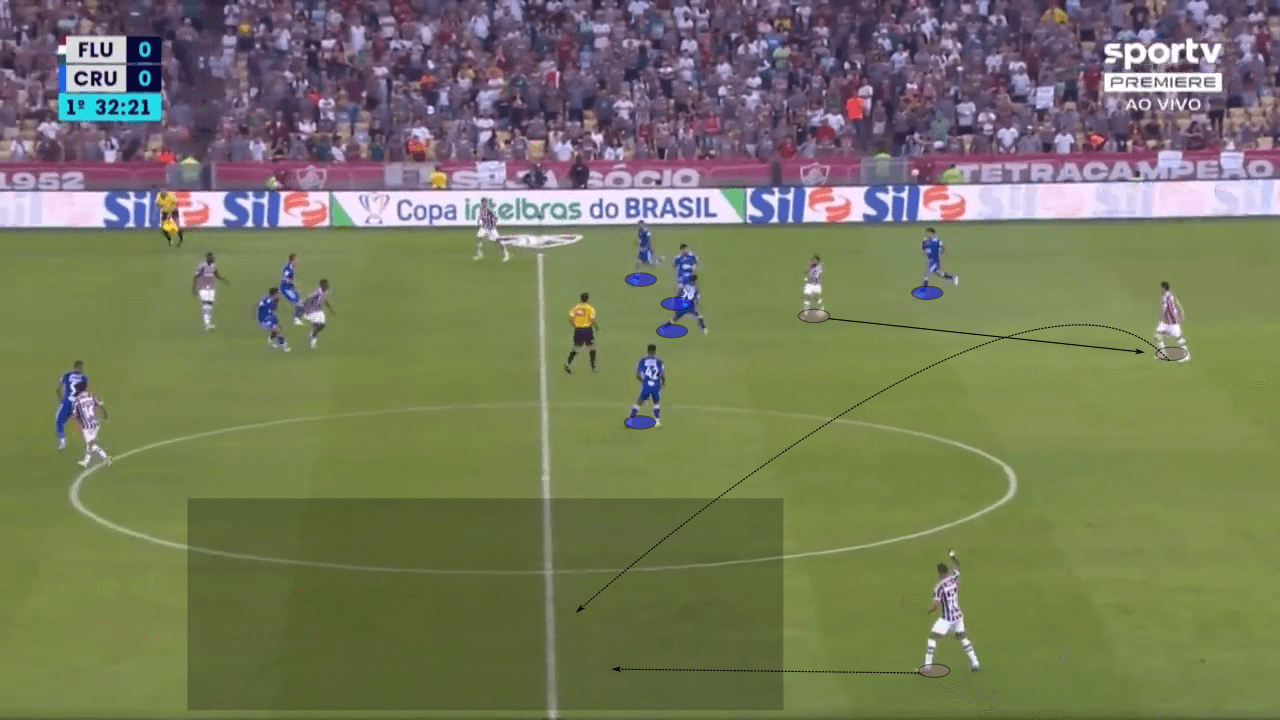
Chance creation
In the final third, their strategy is rather consistent and simple. Of course, at times, they will rely on the brilliance of Ganso or the talent of Jhon Arias, Germán Cano, or Real Betis’ new signing Luiz Henrique. However, they are still able to create chances in a collective and rather controlled manner. As we have seen in the previous two phases, maintaining absolute control of the ball is a priority. This means they often arrive in the final third with control and numbers. Not only is the ball carrier often in dangerous positions, but so are his teammates.
In the example below, Nonato is able to arrive with the ball just in front of the box. As he gets closer, América Mineiro’s defender steps up to close him down, consequently leaving another Flu player alone. Nonato is able to make the through pass and leave his teammate open in front of the goal.
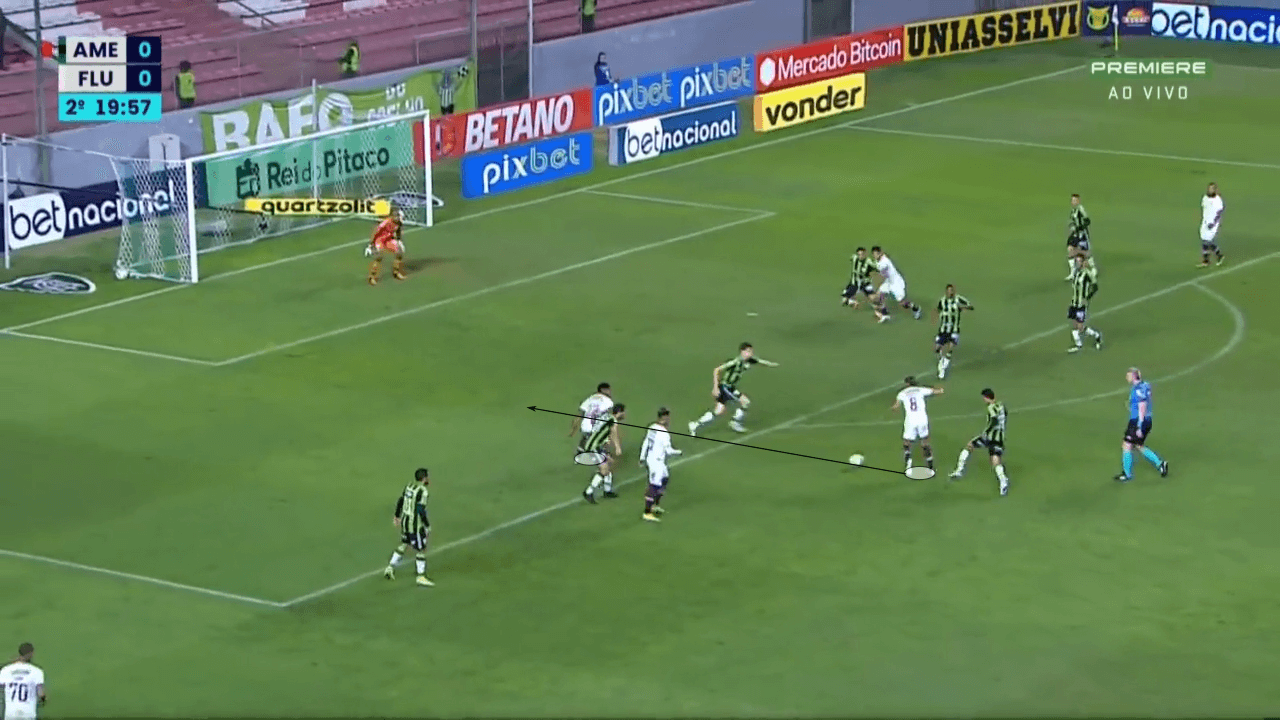
In a similar example, they are able to break Atlético Mineiro’s midfield line and arrive in the final third with danger. As Samuel Xavier receives it, Cano starts making a run in between the two centre-backs. Xavier is able to play the through ball and put him in front of the goal. Attacking the depth is a principle consistently seen in Flu’s attack, especially in the final third.
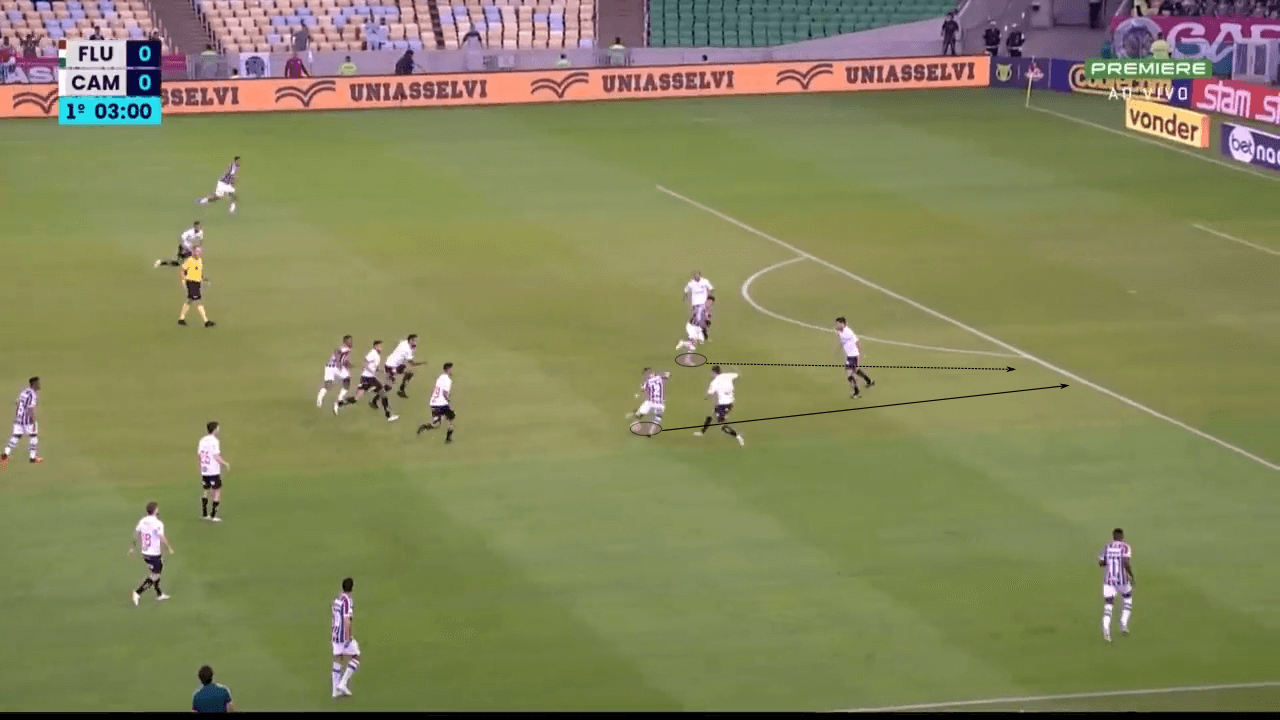
Another example can be seen on the right-wing. Samuel Xavier is able to play Luiz Henrique through and put him behind the defensive line.
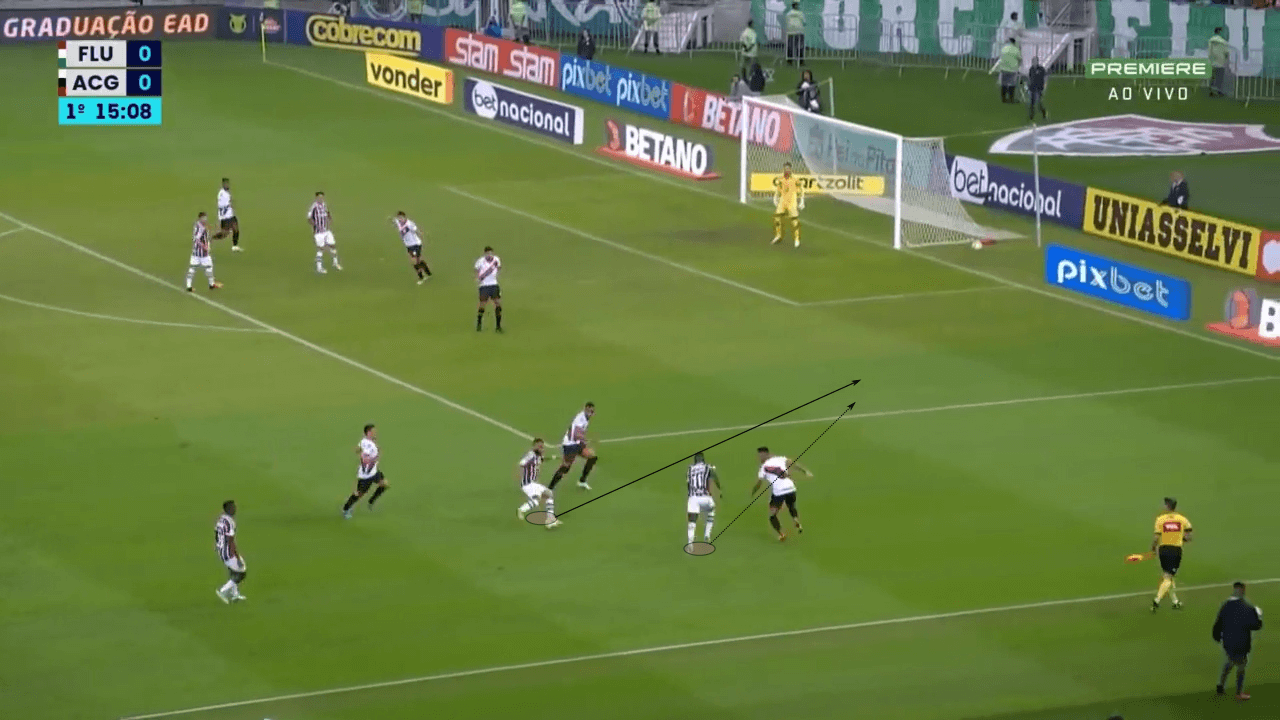
As Luiz Henrique dribbles into the box, he is able to find Cano completely open in front of the goal. In the final third, Diniz gives his players the freedom to create and maximise their talent. There is not much control of the collective behaviour or structure.
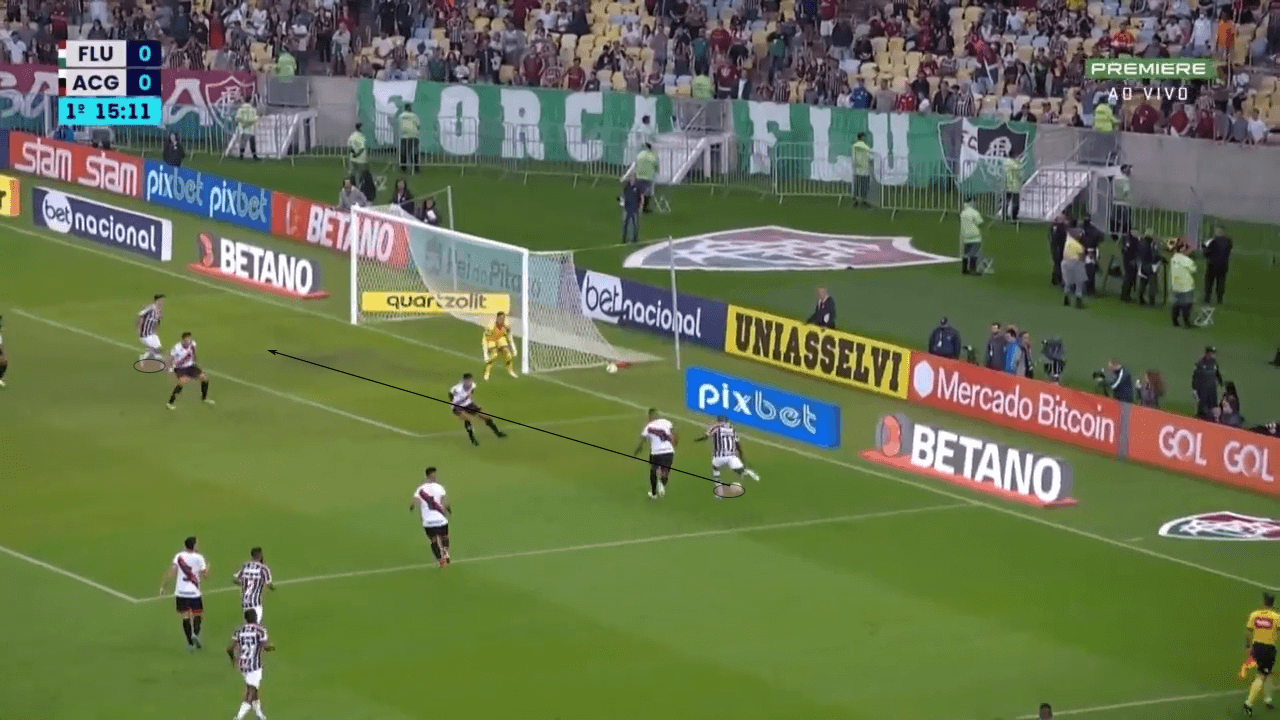
High press
Without the ball, Fernando Diniz adopts an extremely high and intense press. While they are third in the league for challenge intensity at 6.2, they have the highest PPDA at 8.16. Perhaps the most significant factor in dominating possession is their work out of possession. They aim to recover the ball as soon as possible, whether in the defensive phase or in transition. Not only do they press very intensively, but also in an incredibly aggressive manner.
Against Corinthians, we are able to identify this aggressiveness. As Corinthians attempt to build out of the back, Flu move their defensive block into their half. They adapt to Corinthians’ structure and organise themselves accordingly. As Vitor Pereira’s side played with two midfielders, Ganso was free to move up and press alongside Cano. Flu essentially mirrored the opposition’s structure.
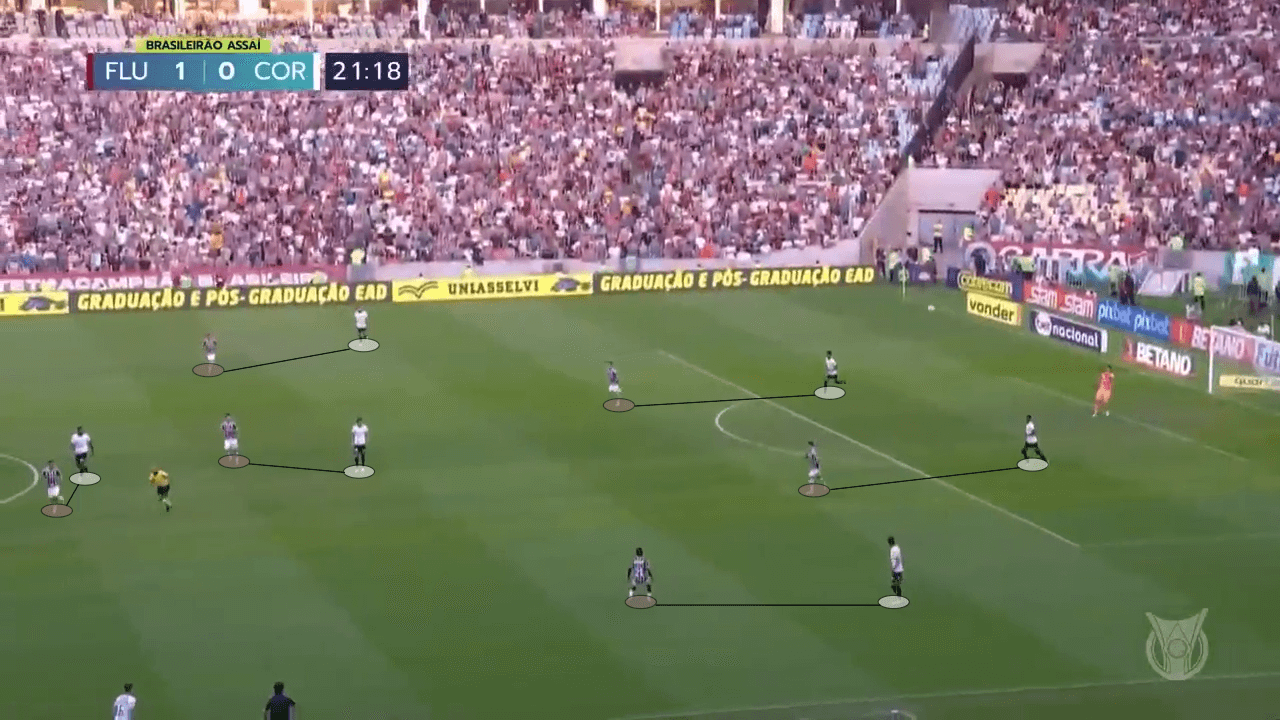
In other cases, Ganso may stay slightly behind Cano and mark the opposition’s defensive midfielder. This can be seen against Avaí, where after the ball is played wide, Flu press them man-to-man with Ganso on the defensive midfielder.
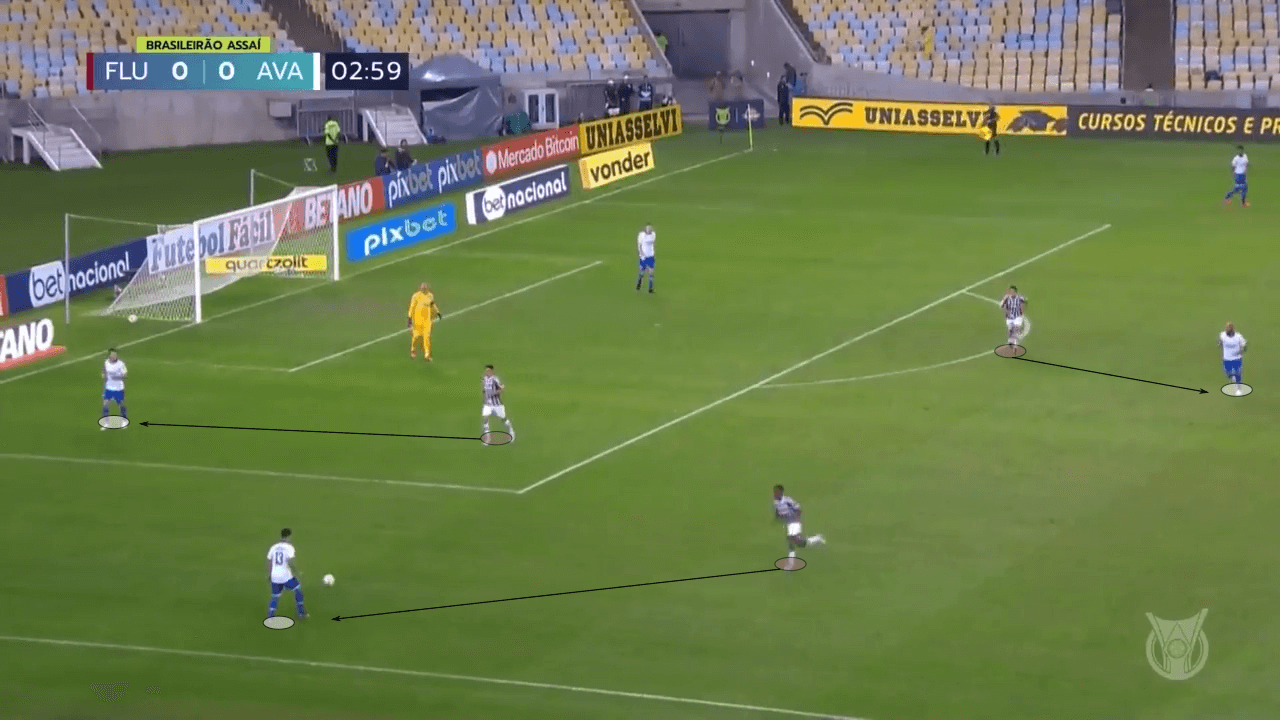
At any rate, a straight man-to-man organisation is consistently adopted in this phase, sometimes even to an extreme extent. Against Cruzeiro below, they throw five players forward, even closing down the goalkeeper. While this may leave them vulnerable behind, it makes it extremely difficult for the opposition to play out.
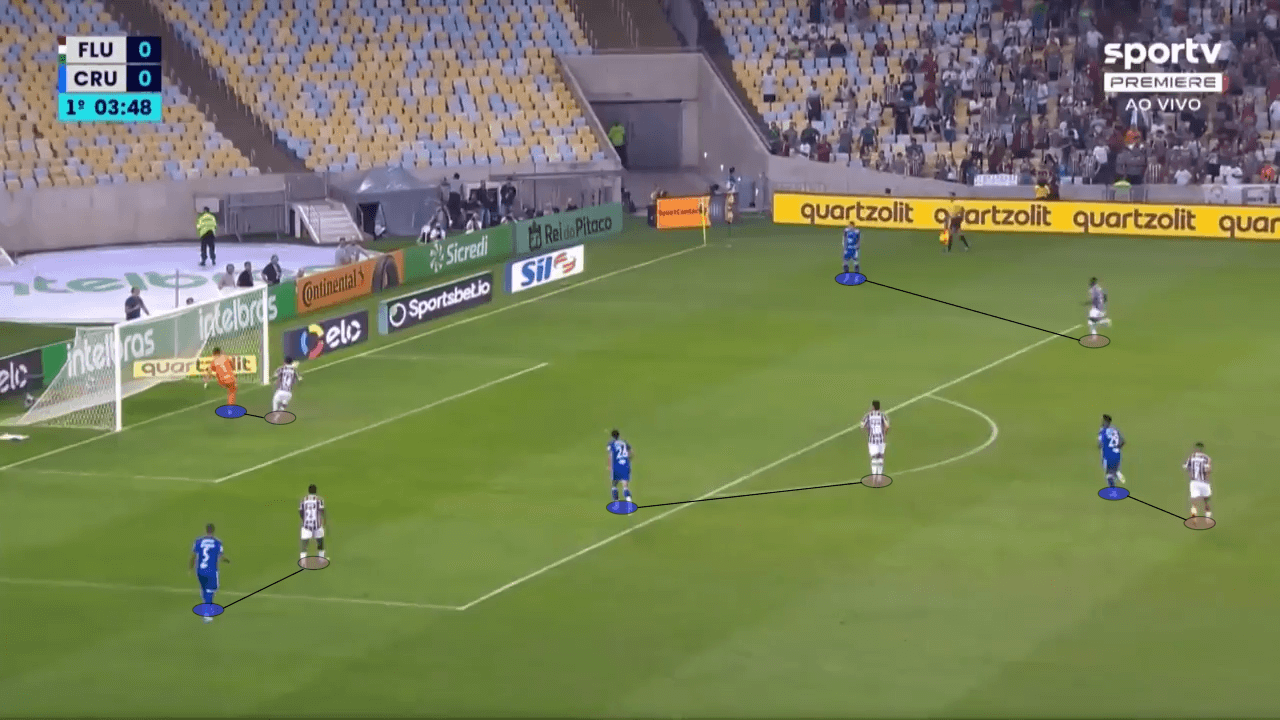
As they frequently dominate possession and always press high, Fluminense are rarely in a low block. Most of their defensive work is conducted in the opposition half, in a high block. The organisation through which they press was examined above, and it is critical to their possession-based approach.
Conclusion
After two rough spells at Santos and Vasco, Fernando Diniz is performing extremely well at Fluminense. The 48-year-old manager is back in the spotlight, and with Tite leaving the national team after the World Cup, he is becoming a serious candidate for the job. With collective attacking football, Diniz continues to delight fans, leading Fluminense back to the top. It will be very interesting to see where Flu finish in the Brasileiro, and if Diniz is indeed given the honour of taking charge of the Seleção.





Comments